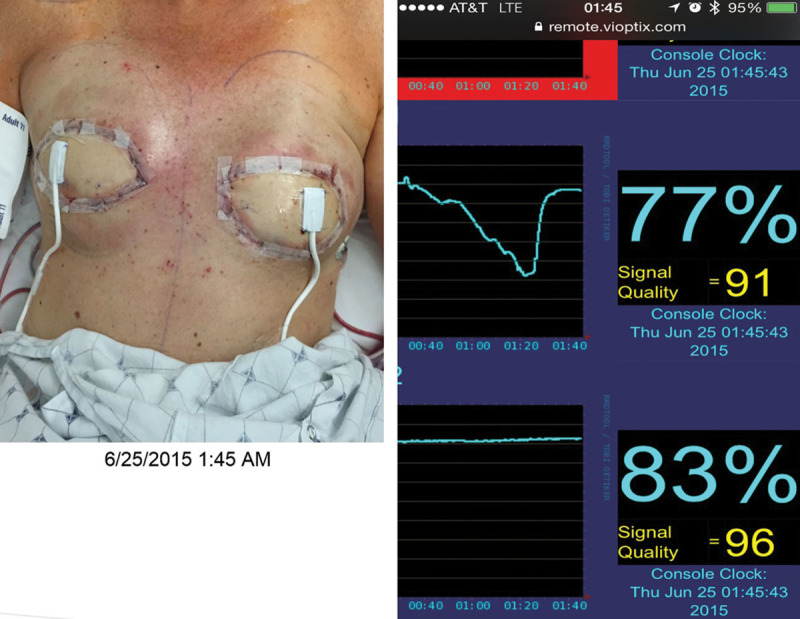Sir:
The vasoconstrictive effects of cigarettes is well documented and routinely discussed with patients seeking microsurgical breast reconstruction. It is generally accepted that patients stop smoking 2–4 weeks before the planned reconstruction to avoid vasoconstriction and to prevent issues with wound healing. Although studies have documented the consequences of cigarette smoking on flap failure and wound healing, no prior study has documented the potential consequence of free flap failure after the use of electronic cigarettes (e-cigarette).1
A 48-year-old woman with right intraductal carcinoma was presented in May 2015 for delayed autologous breast reconstruction. She is a former cigarette smoker who confirmed that she had stopped smoking before scheduling surgery. The patient underwent a bilateral muscle-sparing free transverse rectus abdominis musculocutaneous flap reconstruction without any intraoperative complications. The following morning, the Vioptix Tissue Oximeter (Fremont, Ca) reading on the left breast dropped to 35% with deteriorating clinical examination. Bedside evaluation 20 minutes later revealed a clinically healthy appearing flap with a 77% Vioptix signal (Fig. 1). Transient vasospasm was suspected. On postoperative day 2, the Vioptix reading on the left breast dropped to 3% with progressive flap deterioration. The decision was made to return to the operating room for an exploration. During transport to the operating room, the Vioptix reading returned to baseline; however, the decision to explore the anastomosis was maintained. Exploration revealed widely patient arterial and venous anastomoses without any kinks or twists of the pedicle. Nifedipine (10 mg per os daily) was started for presumed vasospasm. The patient then had an uneventful hospital course and was discharged home on postoperative day 4. It was later revealed to the plastic surgery team by the patient’s mother that the patient had been smoking e-cigarettes until the day of surgery.
Fig. 1.

Photograph of the patient and corresponding Vioptix readings (left flap is top reading, right flap is bottom reading) when initially called to see patient by nursing staff after a drop in the Vioptix reading to 35% on the left side. Upon examining the patient, her left flap appeared clinically healthy and the Vioptix reading rebounded to 77% spontaneously.
E-cigarettes are battery-powered, vaporized nicotine delivery devices introduced into the U.S. in 2007 as a safe alternative to traditional tobacco-based cigarette smoking.2 The use of e-cigarettes has increased in popularity to more than 6% of the population in the U.S. with nearly one third of current smokers reporting to have ever used e-cigarettes.3 E-cigarettes are unregulated by the U.S. Food and Drug Administration and can be bought over the counter or online with no limit on the nicotine content. The vascular consequences of smoking traditional cigarettes/cigars are widely published and routinely counseled to patients; however, few providers discuss the use of e-cigarettes. Although e-cigarettes are free from many of the carbon monoxide, carcinogens, and tobacco present in traditional cigarettes/cigars, they contain variable amounts of nicotine that can cause peripheral vasoconstriction and inhibition of endothelial-dependent vasodilation, which can have devastating effects on free flaps.4 There are few publications about the consequences of e-cigarettes in the plastic surgery literature.5 This case example will help surgeons to advise patients on the risks of all tobacco products including e-cigarettes during the preoperative workup.
DISCLOSURES
M.Y.N. is a consultant for LifeCell. The other authors have no financial interest to declare in relation to the content of this article. The Article Processing Charge was paid for by Dr. Nahabedian.
PATIENT CONSENT
Patient provided consent for the use of her images and there are no patient identifiers in the images used.
REFERENCES
- 1.Moreyra AE, Lacy CR, Wilson AC, et al. Arterial blood nicotine concentration and coronary vasoconstrictive effect of low-nicotine cigarette smoking. Am Heart J. 1992;124.2:392–397. doi: 10.1016/0002-8703(92)90603-s. [DOI] [PubMed] [Google Scholar]
- 2.Richtel M. The e-cigarette industry, waiting to exhale. New York Times. 2013 [Google Scholar]
- 3.King BA, Patel R, Nguyen KH, Dube SR. Trends in awareness and use of electronic cigarettes among US adults, 2010–2013. Nicotine Tobacco Res. 2015;17:219–27. doi: 10.1093/ntr/ntu191. [DOI] [PMC free article] [PubMed] [Google Scholar]
- 4.Sørensen LT. Wound healing and infection in surgery: the pathophysiological impact of smoking, smoking cessation, and nicotine replacement therapy: a systematic review. Ann Surg. 2012;255.6:1069–1079. doi: 10.1097/SLA.0b013e31824f632d. [DOI] [PubMed] [Google Scholar]
- 5.Kempton SJ, Nikki MB, Venkat KR. Electronic cigarettes: have you asked your patients about vaping? Plast Reconstr Surg. 2014;133.6:907e. doi: 10.1097/PRS.0000000000000196. [DOI] [PubMed] [Google Scholar]


